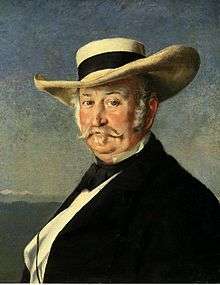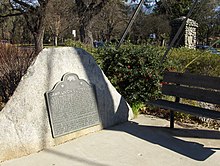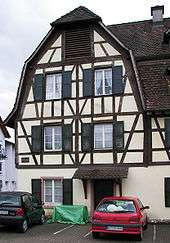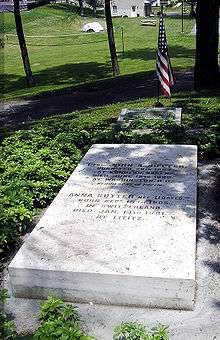John Sutter
John Augustus Sutter (February 23, 1803[1] – June 18, 1880), born Johann August Sutter, was a German-born Swiss immigrant of Mexican and American citizenship, known for establishing Sutter's Fort in the area that would eventually become Sacramento, California, the state's capital. Although he became famous following the discovery of gold by his employee James W. Marshall and the mill-making team at Sutter's Mill, Sutter saw his own business ventures fail during the California Gold Rush. Those of his elder son, John Augustus Sutter Jr., were more successful.[2]
John Sutter | |
|---|---|
 John Sutter, c. 1850 | |
| Born | Johann August Sutter February 23, 1803 |
| Died | June 18, 1880 (aged 77) Washington D.C., United States |
| Spouse(s) | Annette D'beld |
| Children | 5, including John Augustus Sutter Jr. |
Biography
Early life
Johann August Sutter was born[3] on February 23, 1803, in Kandern,[4] Baden (present-day Germany); his father came from the nearby town of Rünenberg in the Canton of Basel in Switzerland.
Johann went to school in Neuchâtel, Switzerland. At age 21, he married[5] the daughter of a rich widow. He operated a store, but showed more interest in spending money than in earning it. Because of family circumstances and mounting debts, Johann faced charges that would have him placed in jail, so he decided to dodge trial and ventured to America; he styled his name as Captain John Augustus Sutter.
In May 1834, he left his wife and five children behind in Burgdorf, Switzerland, and with a French passport, he boarded the ship Sully, which travelled from Le Havre, France, to New York City, where it arrived on July 14, 1834.
The New World
In North America, John August Sutter (as he would call himself for the rest of his life) undertook extensive travels. Before he went to the U.S., he had learned Spanish and English in addition to Swiss French. He and 35 Germans moved from the St. Louis area to Santa Fe, New Mexico, a province of Mexico, then moved to the town of Westport, now the site of Kansas City. On April 1, 1838, he joined a group of missionaries, led by the fur trapper Andrew Drips, and traveled the Oregon Trail to Fort Vancouver in Oregon Territory, which they reached in October. Sutter originally planned to cross the Siskiyou Mountains during the winter, but acting chief factor James Douglas convinced him that such an attempt would be perilous.[6] Sutter was charged £21 by Douglas to arrange transportation on the British bark Columbia for himself and his eight followers.[6]
The Columbia departed Fort Vancouver on November 11 and sailed to the Kingdom of Hawaii, reaching Honolulu on December 9. Sutter had missed the only ship inbound for the Alta California, and had to remain in the Kingdom for four months.[7] Over the months Sutter gained friendly relations with the Euro-American community, dining with the Consuls of the United States of America and the United Kingdom of Great Britain and Ireland, John Coffin Jones and Richard Charlton along with merchants such as American Faxon Atherton.[7] The brig Clementine was eventually hired by Sutter to take freight provisions and general merchandise for New Archangel (now known as Sitka), the capital of the Russian-American Company colonies in Russian America. Joining the crew as unpaid supercargo, Sutter, 10 Native Hawaiians laborers and several other followers embarked on April 20, 1839.[8] Staying at New Archangel for a month, Sutter joined several balls hosted by Governor Kupreyanov, who likely gave help in determining the course of the Sacramento River.[8] The Clementine then sailed for Alta California, arriving on July 1, 1839, at Yerba Buena (now San Francisco), which at that time was only a small seaport town.
Beginnings of Sutter's Fort

At the time of Sutter's arrival, Alta California was a province of Mexico and had a population of only about 1,000 Europeans and an estimated 100,000-700,000 Native Americans. Sutter had to go to the capital at Monterey to obtain permission from the governor, Juan Bautista Alvarado, to settle in the territory. Alvarado saw Sutter's plan of establishing a colony in Central Valley as useful in "buttressing the frontier which he was trying to maintain against Indians, Russians, Americans and British."[9]
The governor stipulated however that for Sutter to qualify for land ownership, he had to reside in the territory for a year and become a Mexican citizen, which he did on August 29, 1840.[9] Construction was begun in August 1839 on a fortified settlement which Sutter named New Helvetia, or "New Switzerland," after his homeland, "Helvetia" being the Latin name for Switzerland. Sutter often began to identify himself as 'Captain Sutter of the Swiss Guard'. When the settlement was completed in 1841, on June 18, he received title to 48,827 acres (197.60 km2) on the Sacramento River. The site is now part of the California state capital of Sacramento.

A Francophile, Sutter threatened to raise the French flag over California and place New Helvetia under French protection,[10] but in 1846 California was occupied by the United States in the Mexican–American War. Sutter at first supported the establishment of an independent California Republic but when United States troops under John C. Frémont briefly seized control of his fort, Sutter did not resist because he was outnumbered.
Relationship with Native Americans
Sutter had to make peace with the local native Maidu people. Over time, the Maidu and Sutter became friends, and they helped Sutter and his Kanakas build a fortified settlement. Sutter called the place New Helvetia or “New Switzerland.” Sutter's Fort had a central building made of adobe bricks, surrounded by a high wall with protection on opposite corners to guard against attack. It also had workshops and stores that produced all goods necessary for the New Helvetia settlement.
Sutter employed or enslaved Native Americans of the Miwok and Maidu tribes, the Hawaiians (Kanakas) he had brought, and also employed some Europeans at his compound. He envisioned creating an agricultural utopia, and for a time the settlement was in fact quite large and prosperous. Prior to the Gold Rush, it was the destination for most immigrants entering California via the high passes of the Sierra Nevada, including the ill-fated Donner Party of 1846, for whose rescue Sutter contributed supplies.
Some Native Americans worked voluntarily for Sutter (e.g. Nisenans. Miwoks, Ochecames), but others were subjected to varying degrees of coercion that resembled slavery or serfdom.[11] Sutter believed that Native Americans must be kept "strictly under fear" in order to serve white landowners.[11] Sutter's Native American "employees" slept on bare floors in locked rooms without sanitation, and ate from troughs made from hollowed tree trunks.[12] If Indians refused to work for him, Sutter responded with violence. Theodor Cordua, a German immigrant who leased land from Sutter, wrote:
“When Sutter established himself in 1839 in the Sacramento Valley, new misfortune came upon these peaceful natives of the country. Their services were demanded immediately. Those who did not want to work were considered as enemies. With other tribes the field was taken against the hostile Indian. Declaration of war was not made. The villages were attacked usually before daybreak when everybody was still asleep. Neither old nor young was spared by the enemy, and often the Sacramento River was colored red by the blood of the innocent Indians, for these villages usually were situated at the banks of the rivers. During a campaign one section of the attackers fell upon the village by way of land. All the Indians of the attacked village naturally fled to find protection on the other bank of the river. But there they were awaited by the other half of the enemy and thus the unhappy people were shot and killed with rifles from both sides of the river. Seldom an Indian escaped such an attack, and those who were not murdered were captured. All children from six to fifteen years of age were usually taken by the greedy white people. The village was burned down and the few Indians who had escaped with their lives were left to their fate.”[13]
In 1846, the American James Clyman wrote that Sutter and Indigenous allies, “keeps 600 to 800 Indians in a complete state of slavery."[14] On February 28, 1847 were the Kern and Sutter massacres, in which 20 California Indians were killed.
Beginning of the Gold Rush

In 1848, gold was discovered in that area. Initially, one of Sutter's most trusted employees, James W. Marshall, found gold at Sutter's Mill. It started when Sutter hired Marshall, a New Jersey native who had served with John C. Frémont in the Bear Flag revolt, to build a water-driven sawmill in Coloma, along the American River. Sutter was intent on building a city on his property (not yet named Sacramento), including housing and a wharf on the Sacramento River, and needed lumber for the construction. One morning, as Marshall inspected the tailrace for silt and debris, he noticed some gold nuggets and brought them to Sutter's attention. Together, they read an encyclopedia entry on gold and performed primitive tests to confirm whether it was precious metal. Sutter concluded that it was, in fact, gold, but he was very anxious that the discovery not disrupt his plans for construction and farming. At the same time, he set about gaining legitimate title to as much land near the discovery as possible.
Sutter's attempt at keeping the gold discovery quiet failed when merchant and newspaper publisher Samuel Brannan returned from Sutter's Mill to San Francisco with gold he had acquired there and began publicizing the find. Large crowds of people overran the land and destroyed nearly everything Sutter had worked for. To avoid losing everything, Sutter deeded his remaining land to his son John Augustus Sutter Jr. The younger Sutter, who had come from Switzerland and joined his father in September 1848, saw the commercial possibilities of the land and promptly started plans for building a new town he named Sacramento, after the Sacramento River. The elder Sutter deeply resented this; he had wanted the town named Sutterville (for them) and for it to be built near New Helvetia.
Sutter gave up New Helvetia to pay the last of his debts. He rejoined his family and lived in Hock Farm (in California along the Feather River).
Land grant challenge


Sutter's El Sobrante (Spanish for leftover) land grant was challenged by the Squatter's Association, and in 1858 the U.S. Supreme Court denied its validity.
Sutter got a letter of introduction to the Congress of the United States from the governor of California. He moved to Washington D.C. at the end of 1865, after Hock Farm was destroyed by fire in June 1865.
Sutter sought reimbursement of his losses associated with the Gold Rush. He received a pension of US$250 a month as a reimbursement of taxes paid on the Sobrante grant at the time Sutter considered it his own. He and wife Annette moved to Lititz, Pennsylvania in 1871. The proximity to Washington, D.C. along with the reputed healing qualities of Lititz Springs appealed to the aging Sutter. He also wanted three of his grandchildren (he had grandchildren in Acapulco, Mexico, as well) to have the benefits of the fine private Moravian Schools. After having prospectors destroy his crops and slaughter cows leaving everything but his own gold, John Sutter spent the rest of his life trying to get the government to pay him for his losses, but he never had any luck.
Sutter built his home across from the Lititz Springs Hotel, the present-day General Sutter Inn. For more than fifteen years, Sutter petitioned Congress for restitution but little was done. On June 16, 1880, Congress adjourned, once again, without action on a bill which would have given Sutter US$50,000. Two days later, on June 18, 1880, Sutter died in the Made's Hotel in Washington D.C. He was returned to Lititz and is buried adjacent to God's Acre, the Moravian Graveyard; Anna Sutter died the following January and is buried with him.
Legacy
There are numerous California landmarks bearing the name of Sutter. Sutter Street in San Francisco, California is named for John A. Sutter. Sutter's Landing, Sutterville Road, Sutter Middle School, Sutter's Mill School, and Sutterville Elementary School in Sacramento, California are all named after him. The Sutterville Bend of the Sacramento River is named for Sutter, as is Sutter Health, a non-profit health care system in Northern California. The City of Sutter Creek, California is also named after him. In Acapulco, Mexico, the property that used to belong to John Augustus Sutter Jr. became the Hotel Sutter, which is still in service. The Sutter Buttes, a mountain range near Yuba City, California, and Sutter County, California (of which Yuba City is the seat) are named after him as well.
The Johann Agust Sutter House in Lititz, Pennsylvania was listed on the National Register of Historic Places in 1982.[15]
The 'Sutter's Gold' rose, an orange blend hybrid tea rose bred by Herbert C. Swim, was named after him.[16]
Gov. Jerry Brown, elected to a third term in 2010, had a Welsh corgi named Sutter Brown, affectionately referred to as the First Dog of California. Sutter died in late 2016 from cancer.
Pop culture
Scholarly studies
- Albert L. Hurtado, John Sutter: A Life on the North American Frontier (2006) University of Oklahoma Press, 416 pp. ISBN 0-8061-3772-X.
Films
- Days of '49 (1924, serial), with Charles Brinley as Sutter
- California in '49 (1924), with Charles Brinley as Sutter
- The Kaiser of California (1936), with Luis Trenker as Sutter
- Sutter's Gold (1936), with Edward Arnold as Sutter
- Kit Carson (1940), with Edwin Maxwell as Sutter
- "The Pathfinder" (The Great Adventure, 1964), with Carroll O'Connor as Sutter
- Fortune (1969), with Pierre Michael as Sutter
- Donner Pass: The Road to Survival (1978), with Royal Dano as Sutter
- The Chisholms, CBS miniseries, role of Sutter played by Ben Piazza (1980)
- California Gold Rush (1981), with John Dehner as Sutter
- Dream West (1986), with Jerry Orbach as Sutter
- General Sutter (1999), with Hannes Schmidhauser as Sutter
Comics
- Tex Willer Special#9: La Valle del Terrore (1996) by Claudio Nizzi and Magnus
Music
- "Sutter's Mill", a song by Dan Fogelberg (1985)
Literature
- "L'Or", a novel by Blaise Cendrars (1925). A character sketch, it portrays his life as more tragic than it really was.
- Stefan Zweig narrates Sutter's story in one of his Sternstunden der Menschheit (1927) called Die Entdeckung Eldorados (The Discovery of Eldorado).
- Luis Trenker Der Kaiser von Kalifornien, 1961 novelization of his 1936 screenplay, in turn based on L'Or
- "John Sutter", a poem by Yvor Winters (1960)[17]
- "Tex Willer: La valle del terrore", comic book written by Claudio Nizzi, drawings by Magnus
See also
| Wikimedia Commons has media related to John Sutter. |
References
- Historisches Lexikon der Schweiz
- Sutter, John A. Jr. & Ottley, Allan R. (Ed.). Statement: Regarding Early California Experiences. Sacramento Book Collectors Club. 1943.
- Bernard Degen: Sutter, John (General Sutter) in German, French and Italian in the online Historical Dictionary of Switzerland, June 7, 2012.
- Eric Howard, John Sutter, California and Californians, Vol. 4.[database on-line]. Provo, UT, USA: The Generations Network, Inc., 1998. Original data: Hunt, Rockwell D., ed. California and Californians. Vol. IV. Chicago, IL, USA: Lewis Publishing, 1932. pp. 36, 37.
- Owens, Kenneth N.; Sutter, John Augustus (November 1, 2002) [1st. Pub. 1994]. John Sutter and a Wider West. University of Nebraska Press. p. 78. ISBN 0-8032-8618-X.
- Dillion, Richard. Fool's Gold, the Decline and Fall of Captain John Sutter of California. New York City: Coward-McCann. 1967, p. 66.
- Dillion (1967), p. 70.
- Dillion (1967), pp. 72-73.
- Dillion (1967), pp. 76–77.
- Chalmers, Claudine (March–April 1998). "The French in Early California". Ancestry Magazine. 16 (2). Retrieved October 8, 2007.
- Hurtado, Albert (Spring 1990). "California Indians and the Workaday West: Labor, Assimilation, and Survival". California History. 69 (1): 5. JSTOR 25177303.
- "John Sutter and California's Indians". Historynet.com. Wild West Magazine. Retrieved December 25, 2014.
- Cordua 1933, p. 24.
- Clyman 1871, p. 116.
- "National Register Information System". National Register of Historic Places. National Park Service. July 9, 2010.
- 'Sutter's Gold' Rose
- Yvor Winters, “John Sutter” from The Selected Poems of Yvor Winters, edited by R. L. Barth. Used by permission of Ohio University Press, Athens, Ohio.
External links
- His account of the discovery of gold
- Captain Sutter's account of the first discovery of the gold (illustrated lithograph)
- Collection of John Sutter Journal Entries
- Guide to the John Augustus Sutter Papers at The Bancroft Library
- Finding Aid to the Sutter/Link Family Papers, 1849-1992 (bulk 1849-1964), The Bancroft Library
- Street names in San Francisco
- Sutterville, California State Historic Landmark
- Sutter's Fort, California State Historic Landmark
- General Sutter Inn Lititz, PA
- John A. Sutter Jr. Marker. Spanish (Acapulco) / English (Sacramento)
- . Appletons' Cyclopædia of American Biography. 1889.

